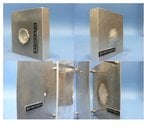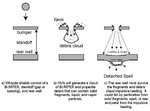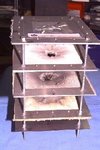Matt308
Glock Perfection
Spacecraft shielding is designed to withstand a majority of the micrometeoroid and orbital debris (MMOD) particles that can impact a spacecraft, thus reducing the likelihood of serious damage to the vehicle and/or crew. Shielding is one part of an overall strategy to reduce impact risk that can also include collision warning and avoidance. Although it is not possible to eliminate all impact risk, shields are designed to meet or exceed probability-based protection limits.
One way to shield against MMOD impacts is to increase the thickness of the spacecraft wall so that the wall remains intact after the impact (see Figure 1). However, this significantly increases the weight of the spacecraft which must be launched into space. A smarter method is to use the "Whipple Shield" concept.
In the 1940s, Fred Whipple proposed a meteoroid shield for spacecraft, called the Whipple shield in recognition of his contribution. The Whipple shield consists of a thin, aluminum "sacrificial" wall mounted at a distance from a rear wall. The function of the first sheet or "BUMPER" is to break up the projectile into a cloud of material containing both projectile and BUMPER debris. This cloud expands while moving across the standoff, resulting in the impactor momentum being distributed over a wide area of the rear wall (Figure 2). The back sheet must be thick enough to withstand the blast loading from the debris cloud and any solid fragments that remain. For most conditions, a Whipple shield results in a significant weight reduction over a single plate, which must be strong enough to receive the projectile kinetic energy in a localized area.
Source: orbitaldebris.jsc.nasa.gov/protect/shielding.html
Figure 1. (Top) Crater formed by a 6.4 mm aluminum sphere impacting at ~7 km/sec. The target is 3.7 cm thick aluminum. (Bottom) The same size and velocity impactor striking a simple Whipple shield with a front sheet thickness of 1.3 mm and a rear wall thickness of 3.2 mm separated by 10.2 cm. Both walls are made of the same aluminum material as the top thick wall.
One way to shield against MMOD impacts is to increase the thickness of the spacecraft wall so that the wall remains intact after the impact (see Figure 1). However, this significantly increases the weight of the spacecraft which must be launched into space. A smarter method is to use the "Whipple Shield" concept.
In the 1940s, Fred Whipple proposed a meteoroid shield for spacecraft, called the Whipple shield in recognition of his contribution. The Whipple shield consists of a thin, aluminum "sacrificial" wall mounted at a distance from a rear wall. The function of the first sheet or "BUMPER" is to break up the projectile into a cloud of material containing both projectile and BUMPER debris. This cloud expands while moving across the standoff, resulting in the impactor momentum being distributed over a wide area of the rear wall (Figure 2). The back sheet must be thick enough to withstand the blast loading from the debris cloud and any solid fragments that remain. For most conditions, a Whipple shield results in a significant weight reduction over a single plate, which must be strong enough to receive the projectile kinetic energy in a localized area.
Source: orbitaldebris.jsc.nasa.gov/protect/shielding.html
Figure 1. (Top) Crater formed by a 6.4 mm aluminum sphere impacting at ~7 km/sec. The target is 3.7 cm thick aluminum. (Bottom) The same size and velocity impactor striking a simple Whipple shield with a front sheet thickness of 1.3 mm and a rear wall thickness of 3.2 mm separated by 10.2 cm. Both walls are made of the same aluminum material as the top thick wall.



